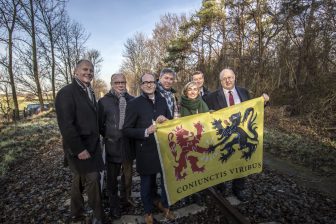Call for proposals 2008 MARCO POLO II Programme
The MARCO POLO II Programme (2007-2013)
Brussels, Belgium – Call for proposals for modal shift, catalyst, motorways of the sea, traffic avoidance and common learning actions under the second Marco Polo Programme (European Parliament and Council Regulation (EC) No 1692/2006 (OJ L 328, 24.11.2006, p. 1). The deadline for submission of proposals is 7 April 2008.
EXECUTIVE SUMMARY
The Marco Polo II programme gives financial support to initiatives taken by commercial undertakings aiming at shifting freight transport off the road or avoiding road freight transport.
Who can participate in the call and be eligible for funding?
Marco Polo II support is open to private and public undertakings (legal persons or entities) engaged in commercial activities. Participants may come from EU Member States, or ‘close third countries’(1). Funding from the EU budget is only available to participants from EU Member States and ’fully participating close third countries’ (2). Participants from other ’close third countries’ are not eligible for funding. Projects must demonstrate a European dimension to be eligible for support. They must cover an international route, either only involving EU territory or EU territory and the territory of a close third country. Furthermore, there must be at least two undertakings from two different countries, at least one of which is an EU Member State. In the case of a transport link with a close third country, in exceptional cases, one undertaking of a Member State may be sufficient.
Marco Polo II support may be given for three main types of initiatives:
Modal shift actions: Provide aid to start up a service or develop an existing service. Projects should aim to shift freight off the road.
• Maximum subsidy of EUR 1 per 500 tonne -km shifted off the road.
• Minimum subsidy threshold EUR 500,000, thus at least 250 million tonne -km to be shifted over
the total length of the contract.
• Subsidy rate can be up to 35% of eligible costs.
• Ancillary infrastructure is not supported (only services).
• Subsidy available for up to three years.
• Support must not unduly distort competition.
• Project must be viable af ter subsidy ends.
Catalyst actions: Aim to overcome structural barriers in the market. Projects should be highly innovative, aiming to achieve a real breakthrough.
• Maximum subsidy is not linked to modal shift but the service has to achieve modal shift.
• Minimum subsidy threshold EUR 2 million.
• Subsidy rate can be up to 35% of eligible costs.
• Infrastructure that is ancillary to the service can be supported.
• Subsidy available for up to five years.
• Project must disseminate its results.
• Political support may be given by the European Commission if required.
• Support must not unduly distort competition.
• Project must be innovative and viable after subsidy ends.
Common learning actions: Aim to improve co-operation and sharing of know -how. Objective is mutual training or exchange of information to help cope with an increasingly complex transport and logistics market.
• Minimum subsidy threshold EUR 250,000.
• Subsidy rate can be up to 50% of eligible costs.
• Subsidy available for up to two years.
• Project must disseminate its results.
• Innovative on a European level.
Motorways of the sea actions: Aim to shift freight from road to short sea shipping or a combination of short sea shipping with other modes of transport.
• Maximum subsidy of 1 EUR per 500 tonne-km shifted off the road.
• Minimum subsidy threshold EUR 2,5 million, thus at least 1,25 billion tonne -km shifted over
the total length of each contract.
• Subsidy rate can be up to 35% of eligible costs.
• Preparatory measures and infrastruc ture ancillary to the action can be supported.
• Subsidy available for up to five years.
• Innovative action.
• Project must disseminate its results and must be viable after the subsidy ends.
Traffic avoidance actions: Aim to integrate transport into prod uction logistics to avoid a large percentage of freight transport by road. These actions are different from the other actions in Marco Polo because avoidance of road transport is in focus instead of modal shift off the road.
• Minimum subsidy threshold EU R 1 million, thus at least 500 million tonne -km or 25 million vehicle-km of freight traffic avoided.
• Maximum subsidy of EUR 1 for avoidance of every 500 tonne -km or 25 vehicle-km of road freight.
• Subsidy rate can be up to 35% of eligible costs.
• Preparatory measures and infrastructure ancillary to the action can be supported.
• Subsidy available for up to five years.
• Innovative action.
• Project must disseminate its results and must lead to a sustainable traffic avoidance of at least 10% of freight volume of existing service s related to road transport flows in production logistics.
Key points for applicants
Proposals can only be submitted in response to an annual call published in the EU’s Official Journal. The Marco Polo website gives indicative dates for forthcoming calls and full information.
Routes used for calculating subsidy
Subsidy calculations are always based on the route the truck would have taken, if the freight had not been shifted to an alternative mode of transport (ship, rail or a combination of ship and rail) or had not been avoided. A practical calculator is available on The Marco Polo website
Tonne-kilometre calculation and funding
Only costs arising on the territory of EU Member States or ‘close third countries’ which have concluded specific agreements with the EUare eligible for Marco Polo II funding. Costs arising in other ‘close third countries’ that have not concludes such agreements are not eligible for funding. Consequently, in calculating the subsidy for each project, only the parts of the route in countries eligible for funding can be used. This also applies in calculating the environmental benefit of the modal shift. Each call will specify the countries eligible.
Projects eligible for support
Only projects concerning freight transport services may be supported by the Marco Polo II programme. Pure infrastructure projects, research and study projects are not eligible for support. Projects that shift goods a non -road mode to another non -road mode are not eligible either.
Participation by public authorities
Only undertakings that are engaged in an economic activity are eligible to participate, but administrations may be up to 100% owners of eligible undertakings.
Selection
When the application period is over, the selection process will take several months. All applicants will be informed of the selection result concerning their projects.
Index of the call
I. Political priorities
II. Call for proposals
App 1 – Definitions
App 2 – How to prepare the proposal
App 3 – Calculation of Modal Shift, Traffic Avoidance and Environmental benefits
App 4 – How to calculate the grant
App 5 – Definition of the award criteria
App 6 – Grounds for exclusion and related administrative and financial penalties
(1) These ‘close third countrie s’ are EEA and EFTA members, candidate countries for EU accession, Mediterranean partner States and other countries with a common border with the Community.
(2) A fully participating close third country’ is a ‘close third country’ that has concluded a specific agreement with the EU. See The Marco Polo website for a list of those countries.
U las zojuist één van de gratis premium artikelen
Onbeperkt lezen? Profiteer nu van de introductieaanbieding voor € 10,- per maand.
Bent u al abonnee?



